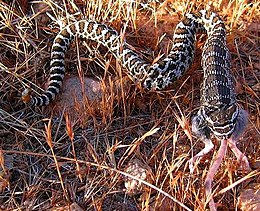
| Part of a series on |
| Evolutionary biology |
|---|
 |
Venom in snakes and some lizards is a form of saliva that has been modified into venom over its evolutionary history.[1] In snakes, venom has evolved to kill or subdue prey, as well as to perform other diet-related functions.[2] While snakes occasionally use their venom in self defense, this is not believed to have had a strong effect on venom evolution.[3] The evolution of venom is thought to be responsible for the enormous expansion of snakes across the globe.[4][5][6]
The evolutionary history of snake venom is a matter of debate. Historically, snake venom was believed to have evolved once, at the base of the Caenophidia, or derived snakes. Molecular studies published beginning in 2006 suggested that venom originated just once among a putative clade of reptiles, called Toxicofera, approximately 170 million years ago.[7] Under this hypothesis, the original toxicoferan venom was a very simple set of proteins that were assembled in a pair of glands. Subsequently, this set of proteins diversified in the various lineages of toxicoferans, including Serpentes, Anguimorpha, and Iguania: several snake lineages also lost the ability to produce venom.[8][9] The Toxicoferan hypothesis was challenged by studies in the mid-2010s, including a 2015 study which found that venom proteins had homologs in many other tissues in the Burmese python.[10][11] The study therefore suggested that venom had evolved independently in different reptile lineages, including once in the Caenophid snakes.[10] Venom containing most extant toxin families is believed to have been present in the last common ancestor of the Caenophidia: these toxins subsequently underwent tremendous diversification, accompanied by changes in the morphology of venom glands and delivery systems.[12]
Snake venom evolution is thought to be driven by an evolutionary arms race between venom proteins and prey physiology.[13] The common mechanism of evolution is thought to be gene duplication followed by natural selection for adaptive traits.[14] The adaptations produced by this process include venom more toxic to specific prey in several lineages,[15][16][17] proteins that pre-digest prey,[18] and a method to track down prey after a bite.[19] These various adaptations of venom have also led to considerable debate about the definition of venom and venomous snakes.[20] Changes in the diet of a lineage have been linked to atrophication of the venom.[8][9]
- ^ Hargreaves et al. (a) 2014.
- ^ Casewell et al. 2013, pp. 218–220.
- ^ Ward-Smith et al. 2020.
- ^ Fry et al. 2012a, pp. 441–442.
- ^ Wuster et al. 2008.
- ^ Lomonte et al. (a) 2014, p. 326.
- ^ Fry et al. 2012a, pp. 434–436.
- ^ a b Fry et al. 2012a, pp. 424–436.
- ^ a b Casewell et al. 2013, pp. 224–227.
- ^ a b Reyes-Velasco et al. 2015.
- ^ Hargreaves et al. (b) 2014, pp. 153–155.
- ^ Xie et al. 2022.
- ^ Casewell et al. 2020, pp. 570–581.
- ^ Casewell et al. 2013, pp. 222–223.
- ^ Barlow et al. 2009, pp. 2447–2448.
- ^ Calvete et al. 2012, pp. 4094–4098.
- ^ Li et al. 2005.
- ^ Mackessy 2010.
- ^ Saviola et al. 2013.
- ^ Fry et al. 2012a, p. 443.